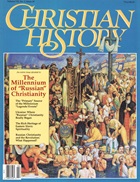Welcome to our issue commemorating the “Christianization of Rus’.” This is a grand historic occasion, and we open the issue with a grand painting of the event that is being celebrated: Prince Vladimir’s overseeing the mass baptism, c. 988, of the people from Kiev, the capital city of Vladimir’s kingdom of Rus’. This is the painting’s story.
Commissioned by the Ukrainian Catholic Synod of Bishops, the original of this painting measures 12 feet long and 6 feet high and hangs in the headquarters of the Ukrainian Catholic Church’s Philadelphia Archdiocese.
In the center of the painting stands the cross of the Lord draped with a white cloth. To the left of the cross is the main focus of the painting, Grand Prince Vladimir (or Volodymyr), ruler of the regions that are today known as Ukraine. To his right stands his new wife, Princess Anna, the sister of the Byzantine co-emperors Basil II and Constantine, and to the royal couple’s left appear their several sons and the sons’ teacher.
Vladimir’s right hand is on the shoulder of his son, Yaroslav, who, when he ascended the throne, continued fostering the Christian faith in Rus’ and came to be known as Yaroslav “the Wise.” In his hands he holds a parchment scroll containing Jesus’ words from Matt. 28:19: “Go, therefore, and teach all nations, baptizing them in the name of the Father, and of the Son, and of the Holy Spirit … ” The scroll was intended to symbolize Vladimir’s handing the new faith over to the succeeding generations of Kievan rulers.
To the right of the princess stands a group of country maidens, with knights and other residents filling in the rest of the scene. The diversity of costumes are an accurate portrayal of the styles of clothing worn by the Kievan peoples in that day.
Immediately in front of the cross are the bishop and clergy involved in carrying out the baptism, while in the far left of the painting appears the drama of the overthrow of the pagan idol, Perun. Infantry and cavalrymen stand by to maintain order.
In the background is the city of Kiev, with a large group of people coming out to be baptized. In the clouds over the city there appears St. Andrew the Apostle, patron saint of Ukraine. The rainbow signifies an end of the kingdom’s turbulent years.
The ornate cross in Vladimir’s left hand represents not only the Christian faith, but the spiritual richness of that faith which shaped the culture of the Ukrainian and Russian nations for centuries to come. In the foreground appears a group of people receiving baptism. The shield held by the young boy standing in front of the prince bears the symbol of the trident, the royal coat-of-arms that was later adopted as a symbol of the Kievan state. This version of the trident was taken by the painter from coins minted during Vladimir’s reign. Incidentally, the man in the water immediately below the shield is actually a self-portrait of the painter, the late Peter Andrusiw.
There is much we need to learn about Christianity “behind the Iron Curtain.” We hope this issue helps you glean its riches.
Copyright © 1988 by the author or Christianity Today/Christian History magazine.
Click here for reprint information on Christian History.

Support Our Work
Subscribe to CT for less than $4.25/month




























